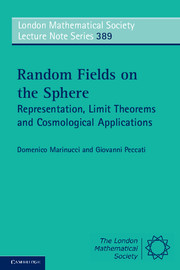Book contents
- Frontmatter
- Contents
- Preface
- 1 Introduction
- 2 Background Results in Representation Theory
- 3 Representations of SO(3) and Harmonic Analysis on S2
- 4 Background Results in Probability and Graphical Methods
- 5 Spectral Representations
- 6 Characterizations of Isotropy
- 7 Limit Theorems for Gaussian Subordinated Random Fields
- 8 Asymptotics for the Sample Power Spectrum
- 9 Asymptotics for Sample Bispectra
- 10 Spherical Needlets and their Asymptotic Properties
- 11 Needlets Estimation of Power Spectrum and Bispectrum
- 12 Spin Random Fields
- 13 Appendix
- References
- Index
3 - Representations of SO(3) and Harmonic Analysis on S2
Published online by Cambridge University Press: 07 October 2011
- Frontmatter
- Contents
- Preface
- 1 Introduction
- 2 Background Results in Representation Theory
- 3 Representations of SO(3) and Harmonic Analysis on S2
- 4 Background Results in Probability and Graphical Methods
- 5 Spectral Representations
- 6 Characterizations of Isotropy
- 7 Limit Theorems for Gaussian Subordinated Random Fields
- 8 Asymptotics for the Sample Power Spectrum
- 9 Asymptotics for Sample Bispectra
- 10 Spherical Needlets and their Asymptotic Properties
- 11 Needlets Estimation of Power Spectrum and Bispectrum
- 12 Spin Random Fields
- 13 Appendix
- References
- Index
Summary
Introduction
In this chapter, we shall specialize the results of Chapter 2 to the compact group which is central for our analysis, namely the “special group of rotations” SO(3). The latter can be realized as the space of 3 × 3 real matrices A such that A′A = I3 (where I3 is the three-dimensional identity matrix) and det(A) = 1. In particular, we shall carry out an explicit construction for a complete set of irreducible representations of SO(3). To do so, we shall first establish a more general result, namely, we will provide (following a classical argument) a complete family of irreducible representations for the group SU(2); we will then recall a well-known relationship between SO(3) and SU(2) (i.e. that the latter “covers” the former twice, i.e. SO(3) ≃ SU(2)/{I2, -I2}, where the 2 × 2 identity matrix I2 is the identity element of SU(2)) and hence show that the representations of SO(3) are a subset of the representations of SU(2). We will then develop Fourier analysis on the sphere, largely by means of the Peter-Weyl Theorem discussed in the previous chapter. In particular, we shall prove that functions on the sphere can be identified with a subset of those on the group SO(3), so that their spectral representation will require only a subset of the matrix coefficients in the representation of the latter (more formally, we shall identify the sphere S2 as the quotient space SO(3)/SO(2)).
- Type
- Chapter
- Information
- Random Fields on the SphereRepresentation, Limit Theorems and Cosmological Applications, pp. 45 - 84Publisher: Cambridge University PressPrint publication year: 2011



